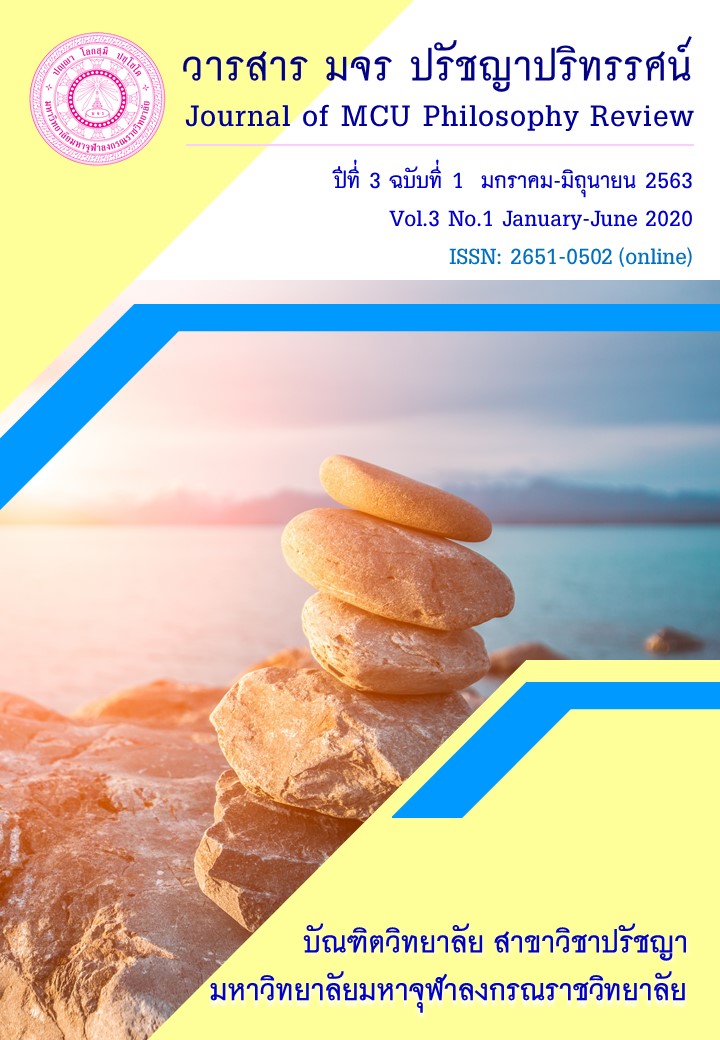Judgment of Aesthetic Value: A Case Study of Sitang Buathong Painting
Main Article Content
Abstract
This article is to study the relationship between art and aesthetics, including a related theory, then apply for analyzing the Sitang Buathong’s Painting. Aesthetics is a branch of philosophy which concerns with a theory of beauty as well as beauty of art. The meaning of art is a beauty of aesthetic value which has the related concepts into aesthetics. The analysis of Sitang Buathong’s Painting is as follow: 1) moralism and subjectivism: it affects to emotion of all people in term of proper and improper art Because the painting which impresses the gesture of pointing finger to the orange is improper, it should put both hands together as respect instead; 2) aestheticism and objectivism: it is a beauty of painting which images to contemporary story of the Buddha’s lifetime, present artist idol, and further audiences who impress an emotion to element of art value; and 3) interactionism and relativism: it does not destroy social morality, at least not an erotic art, it is on need to divide as a bad or good art because it is able to attain the value of life. For the term of new body of knowledge, it is found that for subjective aspect, it affects to social morality overall, both in positive and negative. Judgment of aesthetic value has to consider how the most people do in majority. For objective aspect, the purpose of artist, beauty of individual, and reality of society are the qualification which is a judgment of aesthetic value. For relative aspect, the various opinions of people (Subjectivism) that try to understand the qualification of art which is in itself (Objectivism) make them in unit. But such understanding is different according to the instinct of each person, so judgment of aesthetic value is based on probability.
Article Details
บทความที่ได้รับการตีพิมพ์เป็นลิขสิทธิ์ของวารสาร มจร ปรัชญาปริทรรศน์
ข้อความในบทความที่ได้รับการตีพิมพ์ในวารสาร ถือเป็นความรับผิดชอบของผู้เขียนบทความ และข้อคิดเห็นนั้นไม่ถือว่าเป็นทัศนะและความรับผิดชอบของกองบรรณาธิการวารสาร มจร ปรัชญาปริทรรศน์
References
ขนิษฐา สวัสดิรักษ์. (2553). “จิตรกรรมฝาผนังในพระวิหารและพระอุโบสถวัดบางน้ำผึ้งนอก จังหวัดสมุทรปราการ : งานช่างนอกราชธานีสมัยรัชกาลที่ 4”. การค้นคว้าอิสระตามหลักสูตรปริญญาศิลปศาสตรมหาบัณฑิต สาขาวิชาประวัติศาสตร์ศิลปะ. บัณฑิตวิทยาลัย มหาวิทยาลัยศิลปากร.
จรูญ โกมุทรัตนานนท์. (2539). สุนทรียศาสตร์. กรุงเทพมหานคร : ศูนย์เทคโนโลยีทางการศึกษา มหาวิทยาลัยรังสิต.
ณัฐนนต์ สิปปภากุล. (18 ตุลาคม 2555). จากศิลปะเพื่อชีวิตสู่ศิลปะสร้างสรรค์สังคม. สืบค้นเมื่อวันที่ 6 มิถุนายน 2563, จาก http://art-culture-academy2.blogspot.com/2012/10/004.html.
นิวัติ กองเพียร. (2541). เชิงสังวาส กามรูปในภาพเขียนตามประเพณีที่มีเสียงวรรณคดีไทย. กรุงเทพมหานคร : มติชน.
พ่วง มีนอก. (2530). สุนทรียศาสตร์. กรุงเทพมหานคร : มหาวิทยาลัยรามคำแหง.
ลักษณวัต ปาละรัตน์. (2551). สุนทรียศาสตร์. กรุงเทพมหานคร : มหาวิทยาลัยรามคำแหง.
สำนักข่าวเเนวหน้า. (3 มิถุนายน 2563). ภาพวาดบนผนังโบสถ์ เส้นแบ่งของความพอดี. สืบค้นเมื่อวันที่ 7 มิถุนายน 2563, จาก https://www.naewna.com/politic/columnist/44198.
สำนักข่าวไทยรัฐออนไลน์. (2 มิถุนายน 2563). สั่งแก้ไขภาพ "ส้มหยุด" สิตางศุ์ บัวทอง สำนักพุทธฯ ชี้ ไม่เหมาะสม. สืบค้นเมื่อวันที่ 5 มิถุนายน 2563, จาก https://www.thairath.co.th/news/society/1859501 .
สำนักข่าวผู้จัดการออนไลน์. (1 มิถุนายน 2563ก). "สิตางศุ์ บัวทอง" กับ ตำนานส้มหยุด! โด่งดังจนศิลปินวาดลงผนังโบสถ์วัดดังอุทัยธานี. สืบค้นเมื่อวันที่ 3 มิถุนายน 2563, จากhttps://mgronline.com/onlinesection/detail/9630000056755 .
สำนักข่าวผู้จัดการออนไลน์. (2 มิถุนายน 2563ข). โจ๋งครึ่มกว่าสิตางศุ์ ส้มหยุด! “จิตรกรรมเชิงสังวาส” ภาพอีโรติก-โป๊เปลือย มีภาพในฝาผนังวัดไทยมานานแล้ว. สืบค้นเมื่อวันที่ 8 มิถุนายน 2563, จาก https://mgronline.com/travel/detail/9630000057327.
สำนักข่าวผู้จัดการออนไลน์. (23 พฤษภาคม 2550). มุม "ขำขำ" กับภาพจิตรกรรมฝาผนังไทย. สืบค้นเมื่อวันที่ 6 มิถุนายน 2563, จาก https://mgronline.com/live/detail/9500000059276.
สำนักข่าวสยามรัฐ. (5 มิถุนายน 2563). "สิตางศุ์"สบายใจได้ "เทวัญ"ชี้สำนักพุทธฯไม่มีอำนาจสั่งลบภาพ"ส้มหยุด"บนผนังโบสถ์. สืบค้นเมื่อวันที่ 9 มิถุนายน 2563, จาก https://siamrath.co.th/n/160638.
สีหนาท ลอบมณี. (2561). “รูปโลกีย์”. วิทยานิพนธ์ปรัชญาดุษฎีบัณฑิต สาขาวิชาทัศนศิลป์. บัณฑิตวิทยาลัย มหาวิทยาลัยศิลปากร.
Artytus By jarunapat. (29 May 2020). ตำนานส้มหยุด หยุดโดยไม่มีไรกั้น. สืบค้นเมื่อวันที่ 9 มิถุนายน 2563, จาก https://www.facebook.com/Artytus-By-jarunnapat162014830555482/?epa=SEARCH_BOX
Bell, C. (1958). Art. New York : Capricorn Books.
Croce, B. (1921). The Essence of Aesthetic, trans. Ainslie, D. London : William Heinemann.
Croce, B. (1965). Guide to Aesthetics, trans. Romanell, P. New York : Bobbs-Merrill.
Dowling, C. (No Date). Aesthetic Formalism. Retrieved on June 3, 2020, from https://www.iep.utm.edu/aes-form.
Joad, C.E.M. (1957). Guide to Philosophy. New York : Dover Publications.
Lewis, C.I. (1962). An Analysis of Knowledge and Valuation. LaSalle : Open Court.
Murphey, M.G. (2005). C.I. Lewis: The Last Great Pragmatist. Albany : State University of New York Press.
Plato. (2000). The Republic of Plato. trans. G. T. Cambridge : Cambridge University Press.
Schiller, F. (2010). Essays, Aesthetical And Philosophical : Including The Dissertation On The Connection Between The Animal And Spiritual In Man (1900). Montana : Kessinger Publishing, LLC.
Shelley, P. B. (1962). A Defense of Poetry. Detroit : Wayne State University Press.
Tolstoy, L. (1897). What is Art? Maude, A., trans. New York : Funk & Wagnalls Company.
Wilde, O. (1953). The Critic as Artist. Aldington, R., ed. New York : The Viking Press.


